South America E-Commerce Skin Care Products Market Size
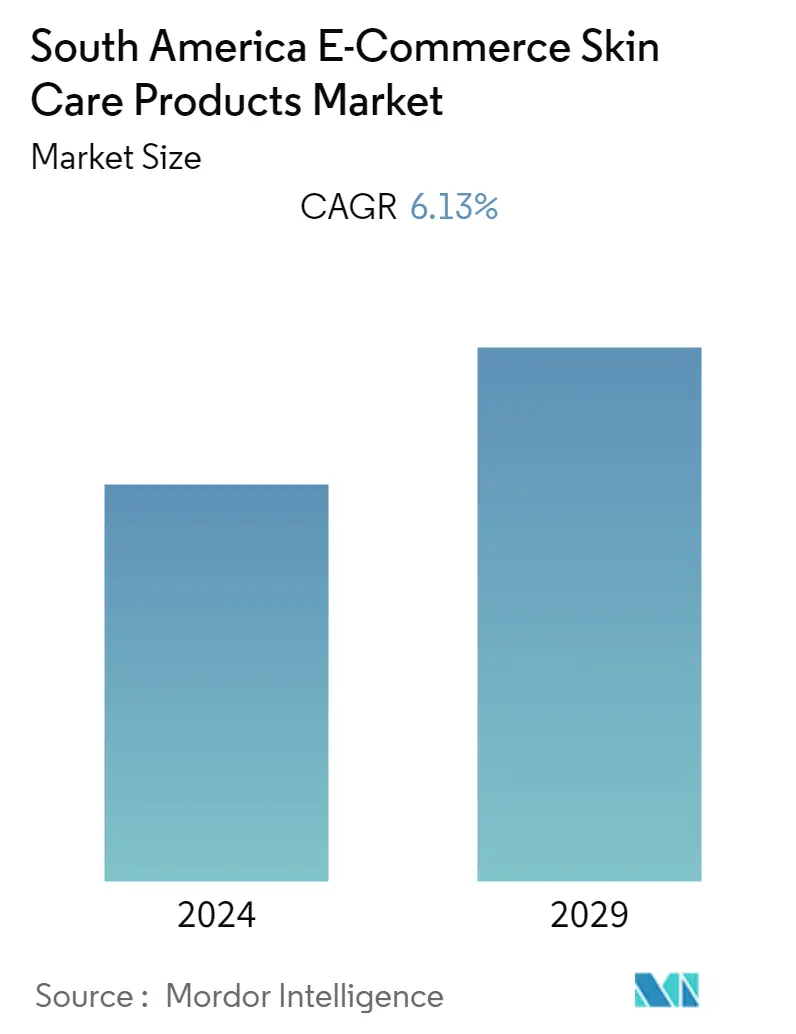
| Study Period | 2019 - 2029 |
| Base Year For Estimation | 2023 |
| Forecast Data Period | 2024 - 2029 |
| Historical Data Period | 2019 - 2022 |
| CAGR | 6.13 % |
| Market Concentration | Low |
Major Players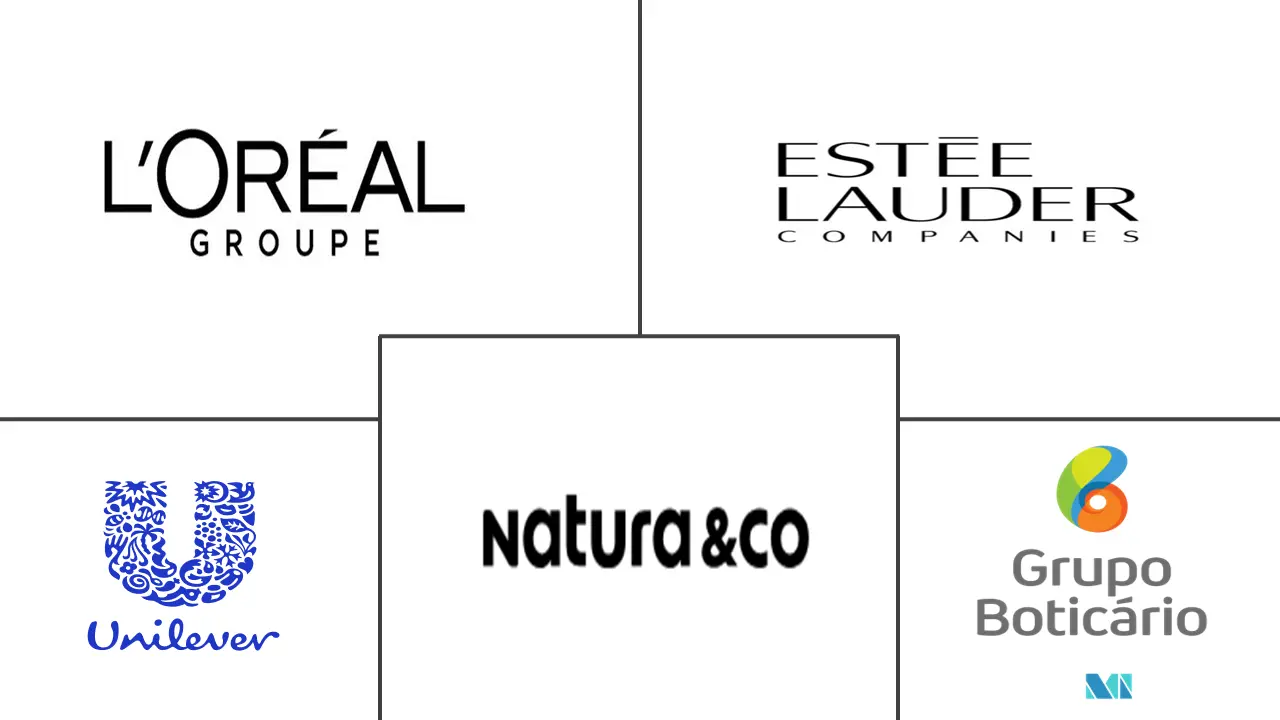
*Disclaimer: Major Players sorted in no particular order |
South America E-Commerce Skin Care Products Market Analysis
The South American e-commerce skin care products market was valued at USD 2.3 billion for the current year and is projected to register a CAGR of 6.13% over the next five years.
- The growing level of customer awareness over their appearance is one of the major reasons driving the market's expansion in the region. Millennials are increasingly embracing personal care products like skincare or body care products as part of their regular grooming routines. For instance, Associaço Brasileira da Industria de Hygiene Pessoal, Perfumaria, and Cosméticos (ABIHPEC) estimate that in 2022, Brazil imported USD 1.52 billion worth of skin care products.
- Also, the market's growth in terms of value sales has been assisted by the straightforward accessibility of these skincare products through various sales channels, such as internet stores and e-commerce operators. For instance, as per the Brazilian Electronic Commerce Association, the revenue from e-commerce in Brazil reached approximately BRL 170 billion in 2022, an increase of 12% from BRL150 billion the year before (2021).
- Additionally, digital substitutes are getting more immersive each year as it supports customizable subscription-based business models that combine the ease of internet shopping coupled with in-person shopping to offer consumers regular deliveries at their doorsteps. Also, the beauty sector has seen a digital change over the past year, partly due to a rise in customer desire for businesses to offer personalized digital experiences.
- To give customers personalized product recommendations and greater purchasing confidence, many firms have integrated virtual try-on and AI-powered website skin diagnosis tools. Augmented reality (AR) has been at the forefront of this digital shift and is quickly becoming a crucial part of a successful omnichannel strategy in the beauty industry, supported by strong data and outstanding results. The shift by businesses and consumers to digital has resulted in the emergence of social forums, communication platforms, and a "beauty community" online in addition to purchasing channels.
- For instance, in September 2021, Coty Inc. expanded beauty tech offerings globally with omnichannel perfect corp. The company announced a multi-channel agreement with leading beauty tech solutions provider Perfect Corp which offers AR (Augmented reality) and AI (Artificial Intelligence) solutions to beauty and personal care companies, among others.
- Furthermore, the vegan (no animal components at all), vegetarian (no byproducts of animal slaughter), and cruelty-free (no animal testing) beauty markets have been increasingly popular in recent years, and they are also beginning to gain traction in Latin America. For instance, Natura & Co, a Brazilian multinational company of cosmetics, hygiene, and beauty products, claims to be Leaping Bunny Certified, which is an internationally recognized cruelty-free program that supports the cruelty-free trade of products.
- Thus, due to the growing demand for such products, businesses are entering the market for organic skin care products. The brand recognition and visibility of cosmetics and personal care goods among consumers have increased as a result of significant investment in advertising and marketing initiatives, including promotions on social networking sites, among others, thus driving the market during the forecast period.
South America E-Commerce Skin Care Products Market Trends
Rising Demand for Natural/Organic Formulation Skin Care Products Via E-Commerce
- Consumers are becoming more concerned due to the side effects of chemicals in skincare goods that have a negative impact on their health, as harmful metals and chemicals are absorbed through the skin, build up in the body, and cause problems, including skin rashes, allergies, and dullness. Thus, customers are increasingly choosing natural goods, which is driving up demand for organic skincare products mostly via e-commerce, as these retailers tend to help the consumers select the specific products pertaining to their concerns/needs by providing multiple category options in a single website.
- Additionally, consumers have embraced natural skincare and cosmetics that are chemical-free and open about their ingredients. Due to this, customers now prefer organic skincare products over synthetic skincare products. With claims like "organic," "vegan," "natural," "chemical-free," and "cruelty-free," manufacturers in the market have been revamping and expanding their product offerings by introducing a wide range of organic skincare products made with plant-based, clean-label ingredients. Natural and environmentally friendly ingredients are preferred by cosmetic makers when creating goods.
- The need for environmentally friendly beauty products is being driven by "green cosmetics." Sustainable components are being used in products by manufacturers who are interested in the topic of sustainable beauty. For instance, in November 2021, Mustela, a French brand, launched its new multifunctional organic balm in Brazil. As per the company, The multi-purpose Balm comes with 3 Avocado Extracts which nourish, repair, and protects dry areas, including the face, lips, hands, feet, elbows, etc. the company claims the product to be certified organic, and 99.7% of ingredients of natural origin.
- Additionally, due to the vast availability of these items on the e-commerce platform, which provides customers with a large range of products and options to pick from, online sales of natural and organic cosmetics products are expanding across the region.
- For instance, as per International Trade Organization, Brazil witnessed a 16% year-over-year increase in e-commerce sales in 2021 and further predicts to grow more than 55.3% by 2025, reaching a value of more than USD 8 trillion. Consequently, the increasing demand for natural and organic cosmetic products is encouraging manufacturers to introduce plant-extracted ingredients and clean-label ingredients mostly via e-commerce, among other distribution channels.
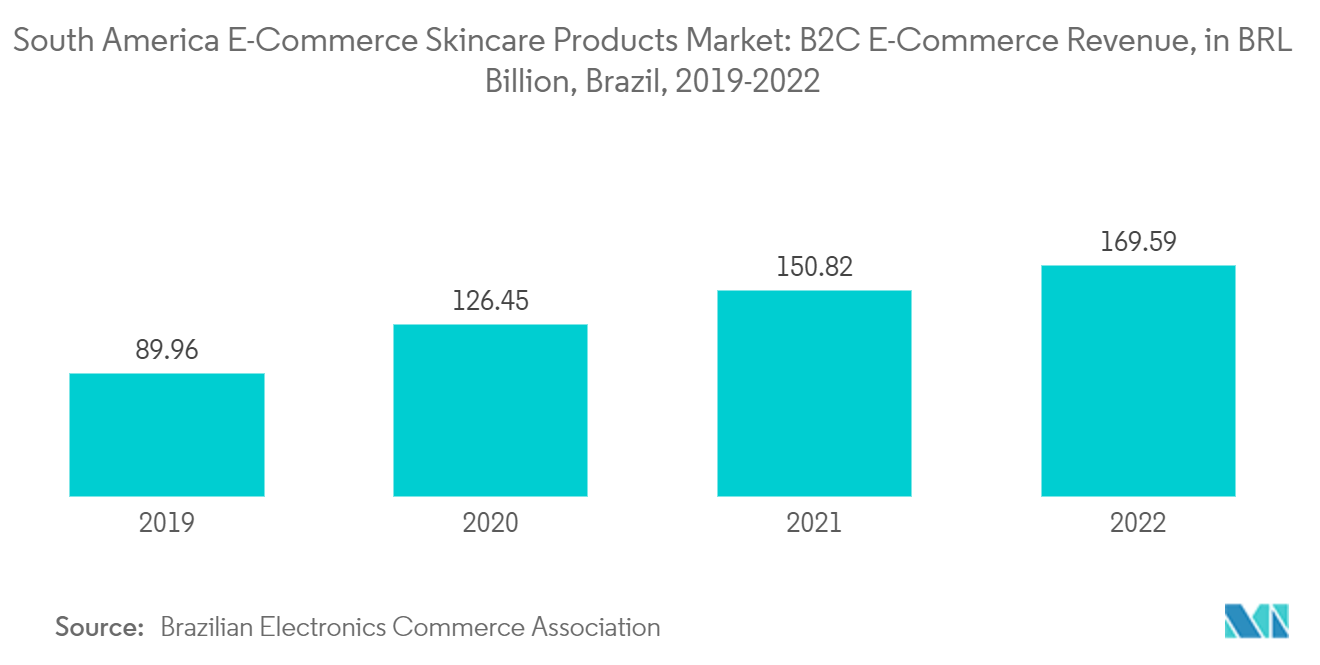
Brazil Holds the Major Share in Skin Care Products Market
- The widespread use of the internet has significantly boosted consumer awareness of skin care products. The demand for skin care products through online channels is being supported by the increasing number of internet and social media users who are active across the country. All beauty and personal care brands are utilizing this opportunity and thus launching their products exclusively via their website or third-party online platforms.
- For instance, in March 2021, Estee Lauder partnered with Sephora Brazil to launch its products in stores and via its online store. The company launched products, including Revitalizing Supreme+, Double Wear, Advanced Night Repair, Pure Color Lipstick, and Bronze Goddess, through the partnership.
- Also, the rise in the number of women working and their desire to purchase skincare products to make their appearance better are both factors contributing to the growth of e-commerce skincare products in Brazil. Additionally, online purchasing offers convenience and a wide range of deals, all of which contribute to the expansion of the online skincare business.
- For instance, according to World Bank, 43.6% of women in Brazil in 2022 are in the labor force, up from 42.6% in 2020. The demand for diverse beauty and personal care products is rising as a result of factors including consumer education and increased awareness about goods and services through digital media and other sources. The demand for these products is thus increased as a result.
- Moreover, increasing e-commerce websites that specifically offer vegan and natural products in the country is also creating more awareness about the benefits of natural products, thus attracting consumers to them. For instance, in November 2022, Costa Brazil launched a new body wash that claims to be made entirely of sustainably sourced ingredients from the heart of the Amazon rainforest. The company claimed that this is a nutrient-rich, handy body wash infused with skin-softening squalane and Amazon-sourced miracle oils.
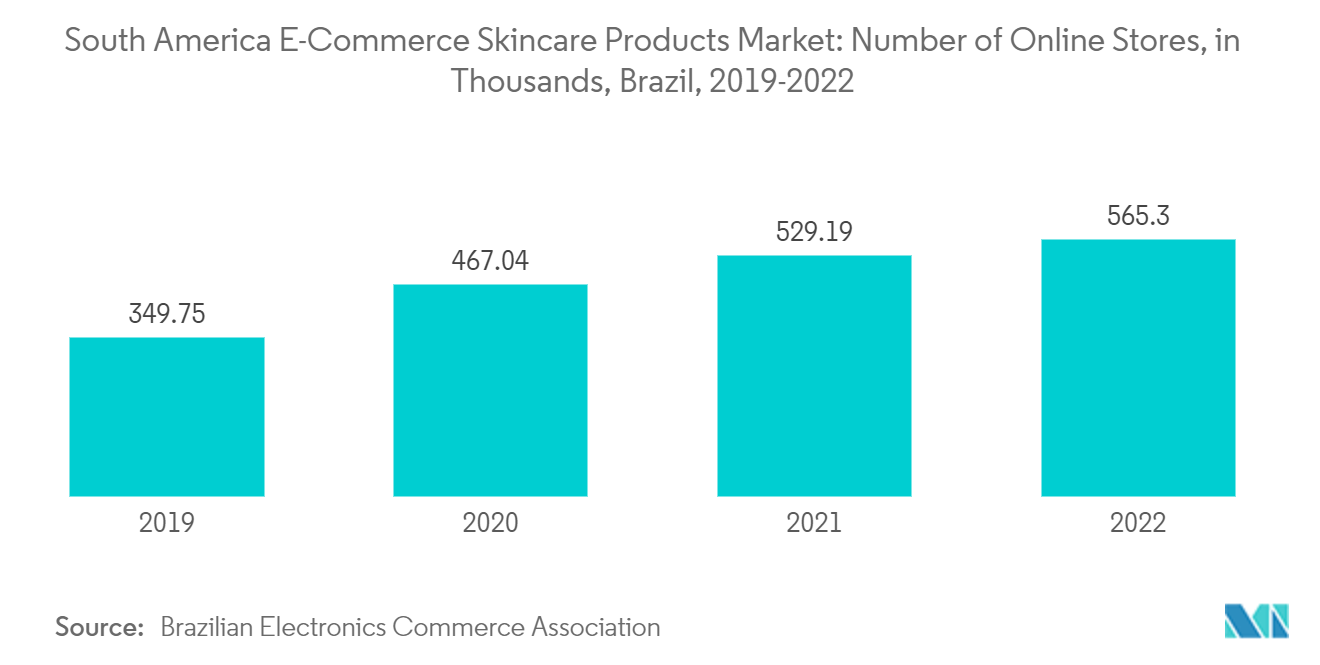
South America E-Commerce Skin Care Products Industry Overview
The Brazil E-Commerce Skin Care Products Market is highly competitive, with the presence of several regional and global players. Some of the prominent players in the market are The Estée Lauder Companies Inc., Natura & Co, L'Oréal S.A., Grupo Boticario, and Unilever PLC, among others.
Some of the strategies adopted by major players to increase their market share are partnering with resellers, investments in technologies, and increasing social media marketing by partnering with regional celebrities. The key businesses are anticipated to compete in the medium term based on sustainable product launches, investments in technologies like virtual reality or augmented reality, and a growing internet presence.
South America E-Commerce Skin Care Products Market Leaders
-
The Estée Lauder Companies Inc.
-
Grupo Boticario
-
Natura & Co
-
L'Oréal S.A.
-
Unilever PLC
*Disclaimer: Major Players sorted in no particular order
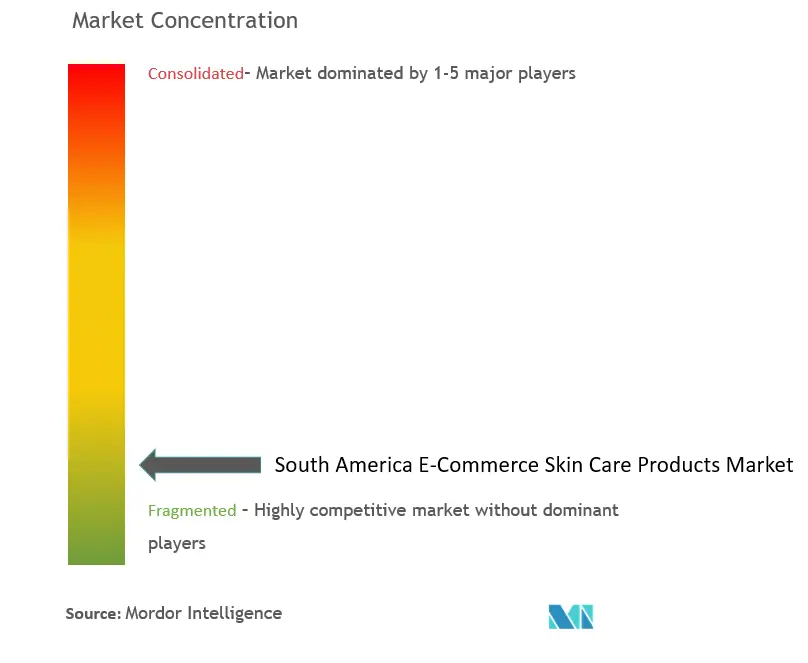
South America E-Commerce Skin Care Products Market News
- April 2023: L'Oréal SA acquired the Aesop brand of Natura &Co's Brazil, which offers hair, body, skin, home, and fragrance products. According to the company, the acquisition of Aesop will lead to a new development cycle for Natura &Co to strengthen its financial structure and will be able to sharpen its focus on its strategic priorities, including its investment plan in Latin America.
- November 2022: Natura&Co company's brand Avon Cosmetics, announced the establishment of new Research and Development operations in Brazil and Poland, which are two of the largest markets in its business, as per the company. The company asserts that this strategy will help it to deliver aspirational beauty through an omnichannel, high-touch relationship selling model.
- October 2022: Grupo Boticário acquired the Brazilian DTC men's brand Dr. Jones, which specializes in products for men's skin, hair, and bathing. To increase the number of customers through Grupo Boticário, the company said that Dr. Jones will still be sold through the brand's online store.
Table of Contents
1. INTRODUCTION
1.1 Study Assumptions and Market Definition
1.2 Scope of the Study
2. RESEARCH METHODOLOGY
3. EXECUTIVE SUMMARY
4. MARKET DYNAMICS
4.1 Market Drivers
4.1.1 Rising Demand for Natural/Organic Formulation Skincare Products Via E-Commerce
4.1.2 Augmented Expenditure on Marketing and Promotional Activities
4.2 Market Restraints
4.2.1 Touch and Feel Factor Restraining the Market Growth
4.3 Porter's Five Forces Analysis
4.3.1 Threat of New Entrants
4.3.2 Bargaining Power of Buyers/Consumers
4.3.3 Bargaining Power of Suppliers
4.3.4 Threat of Substitute Products
4.3.5 Intensity of Competitive Rivalry
5. MARKET SEGMENTATION
5.1 Product Type
5.1.1 Body Care
5.1.2 Facial Care
5.1.3 Lip and Hand Care
5.2 Type
5.2.1 Conventional
5.2.2 Natural/Organic
5.3 Platform Type
5.3.1 Third Party Retailer
5.3.2 Company's Own Website
5.4 Country
5.4.1 Brazil
5.4.2 Argentina
5.4.3 Rest of South America
6. COMPETITIVE LANDSCAPE
6.1 Most Adopted Strategies
6.2 Market Share Analysis
6.3 Company Profiles
6.3.1 L'Oréal S.A.
6.3.2 The Estée Lauder Companies Inc.
6.3.3 Natura & Co
6.3.4 L'Occitane Group
6.3.5 Shiseido Company, Limited
6.3.6 Unilever PLC
6.3.7 Grupo Boticário
6.3.8 The Procter & Gamble Company
6.3.9 Beiersdorf AG
6.3.10 LVMH Moët Hennessy Louis Vuitton
- *List Not Exhaustive
7. MARKET OPPORTUNITIES AND FUTURE TRENDS
South America E-Commerce Skin Care Products Industry Segmentation
The e-commerce skincare products include the sales of a range of products that support skin integrity, improve appearance, and treat skin disorders that are used on the skin to prevent acne, premature aging, and black patches via a digital channel.
The South America E-Commerce Skin Care Products Market is segmented into product type, type, platform type, and country. By product type, the market is segmented into body care, facial care, lip, and hand care. By type, the market is segmented into conventional and natural/organic. By platform type, the market is segmented into third-party retailers and the company's own website. By country, the market is segmented into Brazil, Argentina, and Rest of South America.
The market sizing has been done in value terms in USD for all the abovementioned segments.
| Product Type | |
| Body Care | |
| Facial Care | |
| Lip and Hand Care |
| Type | |
| Conventional | |
| Natural/Organic |
| Platform Type | |
| Third Party Retailer | |
| Company's Own Website |
| Country | |
| Brazil | |
| Argentina | |
| Rest of South America |
Frequently Asked Questions
What is the current South America E-Commerce Skin Care Products Market size?
The South America E-Commerce Skin Care Products Market is projected to register a CAGR of 6.13% during the forecast period (2024-2029)
Who are the key players in South America E-Commerce Skin Care Products Market?
The Estée Lauder Companies Inc., Grupo Boticario, Natura & Co, L'Oréal S.A. and Unilever PLC are the major companies operating in the South America E-Commerce Skin Care Products Market.
What years does this South America E-Commerce Skin Care Products Market cover?
The report covers the South America E-Commerce Skin Care Products Market historical market size for years: 2019, 2020, 2021, 2022 and 2023. The report also forecasts the South America E-Commerce Skin Care Products Market size for years: 2024, 2025, 2026, 2027, 2028 and 2029.
South America E-Commerce Skin Care Products Industry Report
Statistics for the 2024 South America E-Commerce Skin Care Products market share, size and revenue growth rate, created by Mordor Intelligence™ Industry Reports. South America E-Commerce Skin Care Products analysis includes a market forecast outlook to for 2024 to 2029 and historical overview. Get a sample of this industry analysis as a free report PDF download.



